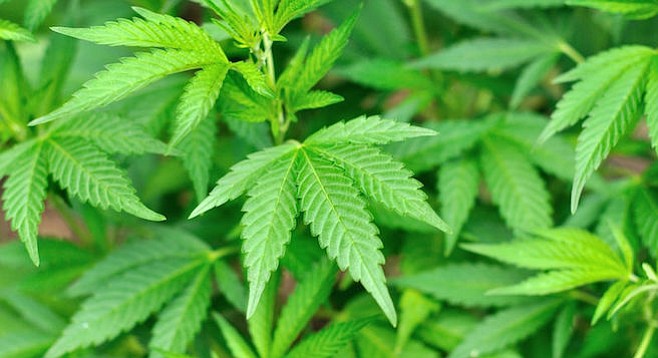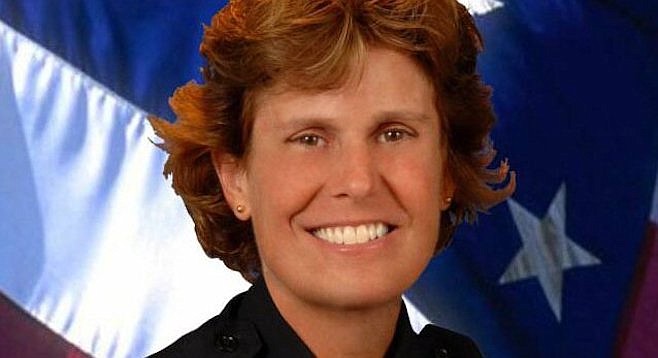 Facebook
Facebook
 X
X
 Instagram
Instagram
 TikTok
TikTok
 Youtube
Youtube

On the eve of the election in which California voters legalized recreational marijuana use in 2016, San Diego police chief Shelley Zimmerman sent a team of narcs to Denver to learn how things were going in one of the first states to legalize recreational marijuana use.

“The negative consequences and sundry effects are enormous,” she said at a meeting in Nestor. “An expanded marijuana industry will be detrimental.”
Zimmerman told a neighborhood group that Colorado has seen an increase in DUI fatalities, children ending up in the emergency room after eating cannabis-infused products, explosions caused by the volatile gases used in the extraction process, and even an increase in homelessness.
A narcotics team, led by Lt. Matt Novak, went to the second annual Marijuana Management Symposium in Denver in July 2016, Novak confirmed. He traveled with two sergeants on the first trip, and returned in October last year with a sergeant, a detective, and a traffic officer to learn about DUI stuff. Once they returned, Novak briefed Zimmerman and his superiors, he indicated. The first trip cost a total of $3200 for three cops, according to city documents. The October trip, with five officers, cost about $5600. The receipts include hotel rooms, meals, Uber trips, air fare, and other travel costs.
Dan Rowland, the director of public affairs for the City of Denver, said the city started holding the conferences because its staff was swamped with calls from cities and agencies in states where cannabis was either legalized or is on the verge of it, including California, Oregon, Maine, and Alaska.
“We were the first major city to implement this in a regulatory environment,” Rowland said. “We are a few years ahead of other places in figuring out how to make this work.”
In their last fiscal year, Colorado collected $115.6 million in tax revenue from cannabis, according to state records. That brings the state’s total revenues from cannabis since July 2014 to nearly half a billion dollars.
But the state has also had to build a regulatory structure from scratch. Regulating weed is not like regulating alcohol, nor is it like regulating produce farming, Rowland said. The July conference was a cops-only affair, Novak said. The October event had a broader audience, including law enforcement, regulators from seed to sale, oversight, health, and taxes.
“There are so many negative issues to the public that arise from marijuana legalization that we wanted to make sure we were well-educated on all the issues that would arise in San Diego so that we can educate our city leaders on what to expect and what to avoid and plan accordingly,” said Novak.
Rowland said the first two events drew so many people they decided to make it an annual conference.
“We have had so much interest from public safety professionals that the 2017 program had a separate track for police and fire departments,” Rowland said. “There’s a ton of public safety issues.” Among them: Illegal growing operations have increased rather than fall off, as cannabis advocates predicted. Growing is legal in Colorado within limits, but people who skirt the rules are growing to ship the weed to states where it’s still illegal.
“They can hide in plain sight,” Rowland said. “Black market sales are up for the same reason.”
Since the cannabis industry is still shut out of the federal banking system, from the wholesale grower to the dispensary, it’s still a cash business. That means the industry’s brick-and-mortar stands are still targeted for robberies and burglaries, Rowland said.
“Their biggest target now is the grow facility and product-preparation places,” Rowland said. “There remains a thriving black market for marijuana.”
Another huge issue has been how to deal with drivers’ cannabis use.
“We’re more and more seeing DUIs with marijuana in the mix of drugs and alcohol,” Rowland said. “It’s difficult to measure marijuana impairment because there is no science on what measurable level constitutes impairment. We usually go with the drugs and alcohol that we can point to to prove impairment.”
The DUI issue was so important that Novak’s team included a traffic officer, he wrote in an email. “[The symposium] had a number of speakers about the need for an increase in DUI drug enforcement because of marijuana legalization and issues associated with it (including DUI marijuana death increases, the difficulty in testing and creating standards for a marijuana DUI),” he wrote. Novak suggested looking at the Rocky Mountain High Intensity Drug Trafficking Area report released in 2016. The report found significant increases in marijuana traffic deaths and emergency-room visits, as well as seeing 20 percent more cannabis use in teens.
It’s important to note that the Rocky Mountain High Intensity Drug Trafficking Area report was funded by federal grants from the Office of National Drug Control Policy. The report was released a month after factcheck.org looked at the draft and found problems with the data and conclusions.


On the eve of the election in which California voters legalized recreational marijuana use in 2016, San Diego police chief Shelley Zimmerman sent a team of narcs to Denver to learn how things were going in one of the first states to legalize recreational marijuana use.

“The negative consequences and sundry effects are enormous,” she said at a meeting in Nestor. “An expanded marijuana industry will be detrimental.”
Zimmerman told a neighborhood group that Colorado has seen an increase in DUI fatalities, children ending up in the emergency room after eating cannabis-infused products, explosions caused by the volatile gases used in the extraction process, and even an increase in homelessness.
A narcotics team, led by Lt. Matt Novak, went to the second annual Marijuana Management Symposium in Denver in July 2016, Novak confirmed. He traveled with two sergeants on the first trip, and returned in October last year with a sergeant, a detective, and a traffic officer to learn about DUI stuff. Once they returned, Novak briefed Zimmerman and his superiors, he indicated. The first trip cost a total of $3200 for three cops, according to city documents. The October trip, with five officers, cost about $5600. The receipts include hotel rooms, meals, Uber trips, air fare, and other travel costs.
Dan Rowland, the director of public affairs for the City of Denver, said the city started holding the conferences because its staff was swamped with calls from cities and agencies in states where cannabis was either legalized or is on the verge of it, including California, Oregon, Maine, and Alaska.
“We were the first major city to implement this in a regulatory environment,” Rowland said. “We are a few years ahead of other places in figuring out how to make this work.”
In their last fiscal year, Colorado collected $115.6 million in tax revenue from cannabis, according to state records. That brings the state’s total revenues from cannabis since July 2014 to nearly half a billion dollars.
But the state has also had to build a regulatory structure from scratch. Regulating weed is not like regulating alcohol, nor is it like regulating produce farming, Rowland said. The July conference was a cops-only affair, Novak said. The October event had a broader audience, including law enforcement, regulators from seed to sale, oversight, health, and taxes.
“There are so many negative issues to the public that arise from marijuana legalization that we wanted to make sure we were well-educated on all the issues that would arise in San Diego so that we can educate our city leaders on what to expect and what to avoid and plan accordingly,” said Novak.
Rowland said the first two events drew so many people they decided to make it an annual conference.
“We have had so much interest from public safety professionals that the 2017 program had a separate track for police and fire departments,” Rowland said. “There’s a ton of public safety issues.” Among them: Illegal growing operations have increased rather than fall off, as cannabis advocates predicted. Growing is legal in Colorado within limits, but people who skirt the rules are growing to ship the weed to states where it’s still illegal.
“They can hide in plain sight,” Rowland said. “Black market sales are up for the same reason.”
Since the cannabis industry is still shut out of the federal banking system, from the wholesale grower to the dispensary, it’s still a cash business. That means the industry’s brick-and-mortar stands are still targeted for robberies and burglaries, Rowland said.
“Their biggest target now is the grow facility and product-preparation places,” Rowland said. “There remains a thriving black market for marijuana.”
Another huge issue has been how to deal with drivers’ cannabis use.
“We’re more and more seeing DUIs with marijuana in the mix of drugs and alcohol,” Rowland said. “It’s difficult to measure marijuana impairment because there is no science on what measurable level constitutes impairment. We usually go with the drugs and alcohol that we can point to to prove impairment.”
The DUI issue was so important that Novak’s team included a traffic officer, he wrote in an email. “[The symposium] had a number of speakers about the need for an increase in DUI drug enforcement because of marijuana legalization and issues associated with it (including DUI marijuana death increases, the difficulty in testing and creating standards for a marijuana DUI),” he wrote. Novak suggested looking at the Rocky Mountain High Intensity Drug Trafficking Area report released in 2016. The report found significant increases in marijuana traffic deaths and emergency-room visits, as well as seeing 20 percent more cannabis use in teens.
It’s important to note that the Rocky Mountain High Intensity Drug Trafficking Area report was funded by federal grants from the Office of National Drug Control Policy. The report was released a month after factcheck.org looked at the draft and found problems with the data and conclusions.
Comments